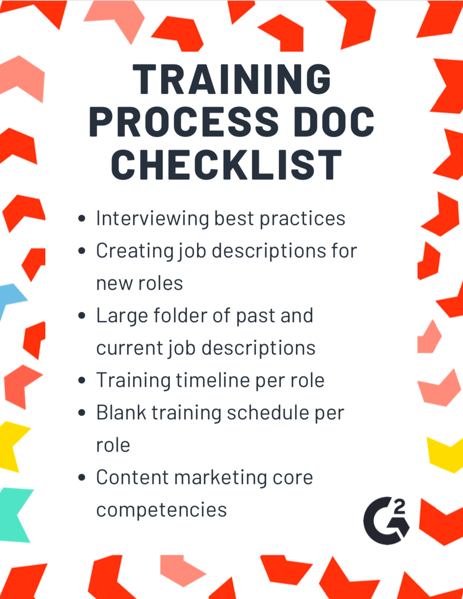It doesn’t matter how many metrics you’re tracking, goals you’ve set or board members you have backing your plans, you need the right people to execute your content marketing strategy to attain the results you want.
The phrase “startup mentality” is ubiquitous, and true. Widely understood to mean “a phase of chaotic growth,” the “startup mentality” often comes with a lack of process and organization in favor of focusing fully on driving rapid growth.
That might work for pushing a product to launch or moving offices with little notice, but when it comes to the actual people making these big things happen, the process and organization is exactly what many folks need to do their best work.
| This is part 5 of The Road to 1M Organic Visits: A Content Marketing Case Study. |
In this piece, we’ll cover some tips for hiring a growth-oriented team, developing processes to keep the team organized, and methods for retaining staff through mutually beneficial feedback.
By the numbers, we’ll talk about how we went from a team of 8 content marketers to 29 in just a few months and how this all led to an increase in traffic to - you guessed it - one million unique monthly visitors.
 Are you inspired by this stock photo?
Are you inspired by this stock photo?
Hiring is time-consuming and emotionally draining. There's no way around that.
Take it from a team that conducted 5-10 interviews a week for four consecutive months to fill more than 20 newly created positions. If you consider that each of those people interviewed actually required 3-4 individual interviews from different members of our team, that’s between 20-40 interviews a week - our HR department truly deserves all the props for facilitating those!
When you’re juggling that many interviews and people, you have to trust your gut and be decisive. That means not making excuses to hire people who may perfectly fit the job criteria but imply that they’d be negative for office culture.
What’s the unspoken subtext of your interviews? Are you really looking for someone with 3-5 years of content marketing experience, or are you looking for someone you click with? That quality is often articulated as “culture fit.” If you’re looking for a good “culture fit,” you can’t be subjective about how you define this.
Spend some time thinking about what makes your company culture special, and talk about that in the interviews. Ask your candidates their ideal work environment and team structure, and see if your answers match. You can learn a lot about a person from several open-ended questions.
If culture fit is the important trait you pick, don't fall into the trap of only picking people like yourself or your current coworkers. “Culture fit” doesn't mean only choosing people that think like you. In fact, that will limit the team more than anything.
It’s worth mentioning that the wild card candidates are often the ones that end up being critical value-adds to the team as a whole. Take a chance on a wild card with a good attitude, strong work ethic and a good sense of humor - it will probably pay off. We hired several “wild cards” who either had limited experience, imperfect writing samples or were doing a career switch, and the diversity of thought that they offer our team has been invaluable.
This all starts with ambitious planning - where does your team see itself in a quarter or a year? Are your goals simply to get more web traffic, or do you also want to build out components of content marketing that are not yet fully developed? In my experience, shoot for the moon with this and get your wishlist on paper (or in a project management platform) because it will help open up the hiring process to more than just simply filling roles.
Understanding that you’re hiring now to fill a writing role that may also eventually have some elements of copy editing, video production, graphic design, email marketing, whatever, is a powerful motivator to look outside the box. Chances are, if you’re looking to do what we all say we want to do and hire smart, talented, open-minded people with strong work ethics, you’ll find people who can - and want to - do many things within their role. In fact, it’s been my experience that people often tailor their resume and interview rhetoric toward the job description (well, the good candidates do, anyway).
If you’re totally sold on your job description as the single source of truth on what the role will entail and nothing else, then great - your work is done. But if, like many of us, you have a general idea of what you want but are open to different variations, it’s worth your time in the interview to spend more time talking about their gifts and passions than drilling them on what kind of content marketing software programs they can use.
Anyone can learn to use Hubspot or Slack, but hiring someone who can clearly articulate their passion and drive will be a rare and valuable addition to your team.
As your team grows and changes, your processes must also grow and change, otherwise, they’ll end up constricting your team’s potential.
We learned this firsthand - as I mentioned before, we had a small team of only 8, and because of the nontraditional way our team was built, we never really had any processes documented. We wrote what we thought would bring in the most traffic with no greater strategy behind it, and we just filled each other in on best practices as they arose.
But, as the team grew, we knew we’d need to button up our processes in order to share them with our incoming team members. That meant a lot of “brain dumps,” where we sat together and talked about the ways we do things, then figured out smart ways to teach and communicate them to different types of learners. These sessions helped create documentation that made sure that our entire team was aligned on how to do our work and create strategies for writing, conversions, and more. The point: documentation is key - and it’s important to outline things even if you think you don’t need to. It will pay off!
Looking at your past metrics is a great indicator of future growth. For example, in 2018, we noticed that our top-performing content was taking 2-4 months for the SEO to really “pop,” garnering the most sustained keywords leading to organic traffic in that time frame.
Thus, when we were making 2019 plans (including the massive hiring push I discussed above), we planned for the same to be true: if we were going to hit our Big Goal by the end of the fiscal year, we needed to hit peak production leading to peak traffic at least 2-4 months before the deadline.
In turn, we needed to do our hiring at the beginning of the year, leave room for training time, ramping people up, and then planning for some larger projects that would impact traffic (a company-wide rebrand that involved changing and migrating our domain). The further ahead you can plan, the better off you’ll be.
Every person on your team, no matter their level or pay grade, has valuable experience and opinions that are worth listening to when a team is being built. If you’re hiring associates, talk to your current associates - what are their pain points? Their favorite things about the job? What do they wish they knew when they were just starting out that you could build into your training now?
Conversely, your higher-level employees have likely been through multiple onboardings at many different companies - tap into their experience to see what they liked and didn’t like so you can get the best of it all.
To take advantage of our team’s knowledge at all levels, we created a training process that involved nearly every person on the team - not only managers - teaching a module of help build team culture. It also helped us to offer different perspectives to our new hires as well, and offer the community we've built more diversity of thought as well.
Though it might feel like giving birth to a baby after you create an absolutely perfect onboarding process document that is definitely, for sure, absolutely going to change the way things are done around here, the truth is that creating a process doc that sits in its original form forever is a fool’s errand. Nothing is perfect, including the perfect document that you’ve spent the last week obsessing over. Make sure that you keep an open mind when it comes to receiving feedback on your process docs - the more honing you do, the better your final product will be.

There’s almost no limit to the number of process docs our team created during the hiring, onboarding and training periods - and there are still many in progress for ongoing opportunities. Here are a few examples of process docs that we found especially helpful:
The most helpful thing that we’ve learned - and it seems deeply obvious in retrospect - is that these process docs require constant re-evaluation. Whether it comes in the form of an anonymous survey sent to the full team to gauge past insights on training and ongoing support, or an informal conversation held at 1:1s with your direct reports, be willing an open to reevaluate the way your team trains and onboards.
There’s no one right way to train a large group of people - it’s simply impossible that a group of, in our case, 20 new hires who started all within the same three months, would all learn and process information exactly the same way.
We learned this through experience - we had a new hire who gave the feedback that she felt a few modules of our training could have been in a different order. I created the document and process based on my own personal writing process. When I brought the conversation to my fellow managers, I learned that there were virtually endless personal writing processes on our team. This helped me, a person whose job responsibilities are generally not closely aligned with those of our full-time writers or link builders, see and understand the training better from their perspective.
Now that you have a better idea of how G2 turned its team of 8 content marketers into nearly 30 in just a few months to drive traffic to a million organic views, you might also be interested in some other articles in this series. Check it out!
It’s a lot of work to get a team of any size fully up to speed on new roles and responsibilities and to develop the systems and processes to evaluate work competency based on performance. But, there’s still more work to be done. For our team, this means not just training to do a job efficiently, but providing even more resources to continue growth and development. Moving forward, our team is developing internal and external educational resources that are tailored toward each job role, consisting of online courses, webinars and seminars, conferences, books and more. As we continue to grow, so too will our goals and our successes!
Amy Lecza (she/her) is the former director of content marketing at G2. Her background is in journalism, PR, and content creation, and she has a degree in both journalism and culinary arts.
#G2Fireside Twitter chat took to discussing content and data this last week.
 by Anastasia Masters
by Anastasia Masters
Content marketers around the world gathered in San Diego this April for the inaugural Content...
 by Devin Pickell
by Devin Pickell
We have entered an era where the visual internet is no longer what it used to be.
 by Malin Pettersen
by Malin Pettersen
#G2Fireside Twitter chat took to discussing content and data this last week.
 by Anastasia Masters
by Anastasia Masters
Content marketers around the world gathered in San Diego this April for the inaugural Content...
 by Devin Pickell
by Devin Pickell


